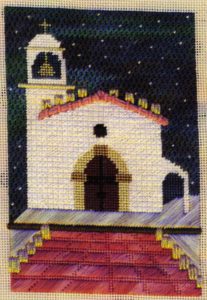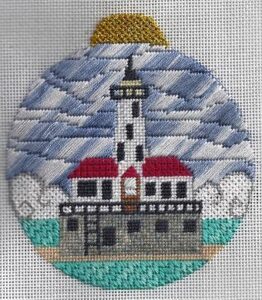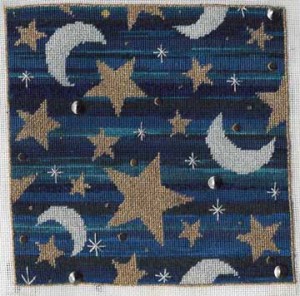
Updated July 4, 2023.
Many of the needlepoint canvases I have in my stash have skies as part or all of the background. But for many years, I was unsatisfied with the stitches and techniques I used for skies. The main problem seemed to be that when Basketweave is used the sky felt or looked too “heavy” for the rest of the piece. If I used an overdye, then there was the diagonal line problem. As a result, I developed a few different methods for handling skies.
Finding threads that work well for skies and then using them correctly is the key to making beautiful skies. The sky, most of the time, is not a uniform color. It is lighter near the horizon and deeper at the zenith, or it has clouds or fog. Because of this lack of uniformity in color, my favorite threads for skies are semi-solid threads. Semi-solid threads are those which have some variation in the value of a single color. Most hand-dyed threads and many overdyed threads are semi-solid. By using a semi-solid thread, the sky looks lighter and more natural. Even if the variation looks almost nonexistent in the skein, there will be enough variation when using hand-dyed threads to make a more realistic sky.
Other threads which work well are those threads that have some variation in shading because of the way they are made. A non-stitching example of this is “heathered” colors in clothes. Those colors have slight variations but in a completely random way.
Good examples of this in needlework threads are Rainbow Tweed from Rainbow Gallery and some colors of Burmilana from Amy’s Keeping Me in Stitches. Another interesting version of this is Baroque Silk. Becue of the way it is dyed, single strands have some variation, most apparent in dark colors.
Nobuko & Night Skies: One of my favorite stitches is Nobuko. I love the way its texture is so irregular, but the stitch is not. Nobuko makes a wonderful background stitch, and I use it often. Perhaps one of its best uses is to make a cloudy night sky. Because the stitch has lots of texture, it looks like the irregular areas of darkness which occur on a cloudy, moonless night. Using an overdyed thread with this stitch emphasizes this feeling. Since the rows of the stitch encroach on each other, using semi-solid threads will not result in stripes, but in irregular swaths of color. The choice of overdye is important; it must be a proper sky color, and it cannot have any colors which would not be found in the sky. If there are colors that don’t work, be brave; cut them out of your working thread! Some Watercolours shades which work really well to show a night sky are Dark Shadows, Charcoal (cut out the green sections), and Indigo. The darker the thread color, the more moonless the night.
But what if there are some stars? If you are using Nobuko, leave occasional Tent Stitches out and replace them with a metallic in pearl, gold, or silver (depending on the piece). A way to add sparkle without stars is to use navy metallic (Kreinik 018HL) which
will add shine, but not color.
Daytime Skies: Stitching an entire sky in Basketweave in a solid color is not the best way to convey the space and openness of a daytime sky. A good alternative is to use a dense darning pattern, stitched with a relatively thick thread. The darning pattern used
should be one which does not have shapes, such as diamonds. It should be a simple alternating pattern.
If you use stranded threads, the number of strands used to stitch the pattern will determine the density of pattern and color. I like to use one fewer strands than I would to do Basketweave. This results in dense color where the exposed canvas threads are secondary. This works especially well on white canvas because little of the canvas will show through. However, if the canvas is blue or the sky is painted, fewer strands can be used. If the painted sky is highly detailed, using only a single strand creates Shadow Stitching and will show off the painting.
A pattern of over three under one, with rows alternating over the open spaces, works well for skies. Variations of patterns like this also work well. Skies done in pattern darning should always use horizontal patterns, unless it’s raining, then use a diagonal pattern.
Because darning patterns are lower than Basketweave, this makes the sky recede from the design, allowing it to accent the focal point. It also makes the sky look bigger and more open.

Random Gobelin Skies: If you want to use this technique, you must decide before you start stitching. Using an extra-fine marker that’s safe for fabric, make lines across the sky, moving randomly together and apart. The lines should never be more than five threads apart. When you get to stitching the sky, stitch in Diagonal Gobelin. In an overdye, it makes a very dramatic sky. Less dramatic, but effective, is this technique in solid threads.

Multi-thread sky: If the sky takes up most of the piece’s background and is a major part of the design, for example, a starry night canvas, a multi-thread sky can enhance this look. Random lengths of different colors create a complex interplay which is very appealing.
Begin by selecting at least six different threads in your choice of color (or very close shades of the same color). These threads should be of different fibers and some, but not all, should be semi-solid overdyes. If you have chosen more than six threads, group them into six piles. Write them down in order.
Take a single die and roll it. The number on the dye tells you the thread you want from your list. Roll the die again. This number tells you how many rows of this color to stitch. It’s as simple as that. The only precaution to take is never to stop and start a color at about the same area in a row. This will keep the sky from looking too regimented.
I got this idea from a knitting book. As you can see by the piece above, it makes a dramatic sky.
About Janet M Perry
Janet Perry is the Internet's leading authority on needlepoint. She designs, teaches and writes, getting raves from her fans for her innovative techniques, extensive knowledge and generous teaching style. A leading writer of stitch guides, she blogs here and lives on an island in the northeast corner of the SF Bay with her family

Love your website – has helped me a lot.
Pat
Love info on multi-thread Sky. Just what I need for a futuristic piece I’m working on. Thank you.